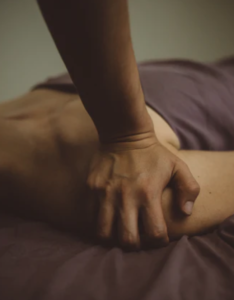Countless studies have shown that massages and massage therapy delivers a number of health benefits. From relaxing spa visits to therapeutic clinical therapies, massage has evolved from being viewed as an accessory service to a legitimate medical treatment.
Massage has been used since ancient times, and techniques have come a long way over the centuries. Whether you’re looking for a natural way to alleviate physical pain after a workout gone wrong or as part of a care regimen or seeking out emotional or mental self-care options, massage is worth considering. Depending on the type of massage you choose, it can be used as part of an ongoing wellness plan or to treat everything from a muscle injury to mental health struggles. Are you wondering if massages are right for your wellness? Discover the many health benefits associated with massage therapy below!
.
Popular Types of Massage
“Not all massage treatments are the same,” says Isabella Kortez, founder and owner of Los Angeles’ luxury Ciel Spa. “It’s important that you choose the right kind for your specific needs because different styles of massage offer unique benefits. There are more than 80 styles of massage practiced in the United States alone, each with their own set of movements, benefits, and targeted areas.”
- Swedish massage is the most popular style of massage. It focuses on the topmost muscles all over the body. If you’re looking into the benefits of massage for the first time, a Swedish massage is a perfect entry point.
- During a Swedish massage, the therapist typically uses a variety of techniques, including circular movements, squeezing, rhythmic tapping, and long, kneading strokes. The main goal is to relax joints and muscles, although this style of massage can be energizing as well.
- Deep tissue massage is commonly used either to treat muscle damage associated with an injury. As the name suggests, the massage therapist uses deep, powerful strokes to work on the deeper layers of muscles and tissue.
- Sports massage, as you might assume, is used to treat or prevent injuries related to intense physical activities. The techniques used are similar to Swedish massage, but with a focus on specific areas related to the athlete’s sport.
- Neuromuscular massage (also known as trigger point massage) involves the manipulation of soft tissues and tight muscles. The massage therapist’s goal is to treat the cause of physical pain, so they apply direct pressure to problematic areas. The massage itself can be painful, but the relief is worth it to many patients.
- Hot stone massage is usually used for relaxation and stress relief. Instead of using their hands, the massage therapist places heated stones on various parts of your body. The addition of heat can provide more relief than physical massages. Hot stone massage is often used alongside Swedish massage techniques.
- Prenatal massage is used to alleviate physical pain and stress, anxiety, and depression associated with pregnancy. It may also help to boost the immune system. Techniques vary depending on the massage therapist. Be sure to speak with your doctor first, as women with certain conditions should not get this treatment. You should only go to a massage therapist who’s certified specifically in prenatal massage, as other techniques could cause complications.
.
.
Common Benefits Associated with Massage
With so many different styles of massage out there, the benefits vary widely; however, there are some common physical, mental, and emotional health benefits you can achieve through massage therapy, including:
- Improved range of motion
- Treatment or prevention injuries
- Alleviate chronic pain
- Reduce stress, anxiety, depression, and other mental health challenges
- Encourage relaxation and a sense of well-being
- Relax tense muscles
- Boost cardiovascular health
- Help insomnia
- Relieve pain in post surgery care
- Lower blood pressure
- Improve immune function
- Reduce the frequency of migraine headaches
- Maintenance and relief from certain conditions including fibromyalgia, osteoarthritis, cancer, or carpal tunnel syndrome
.
Why Massage Works
There’s no single reason why massage is beneficial, and that’s a good thing. When you get a massage, you’ll usually enjoy a number of positive side effects in addition to the targeted therapeutic benefits like loosened muscles and relaxation.
For example, getting a deep tissue massage to reduce pain associated with an injury will also release serotonin, a chemical in your body that naturally boosts your mood and helps to fight depression.
Massage is a multifaceted treatment. It relieves pain by triggering the release of pain-reducing endorphins throughout your body. It also improves mental health by releasing mood-boosting neurotransmitters. Massage can also directly eliminate the cause of pain. The simple act of applying physical pressure in the right ways, for instance, can loosen tight muscles that cause cramping or painful pressure on nerves.
Massage also encourages blood flow to your organs, improves circulation, and reduces blood pressure. Better blood flow naturally comes with a myriad of different health benefits. It can even improve your skin health—skin is the largest human organ, after all, and boosting your blood flow can even reduce the appearance of stretch marks or scars.
Finally, don’t underestimate the power of human contact. Beyond the direct reactions associated with physical contact, massage also forms a human-to-human connection that makes the patient feel cared for and comforted.
.
Is Massage Therapy Right for You?
If you have a specific health condition, talk to your doctor about massage therapy. As a natural treatment, there’s typically very little risk of complications occurring and some insurance companies may even cover visits.
Massage therapy isn’t always a quick fix, but incorporating it into your wellness regimen can be a fantastic way to feel your best, whether you’re targeting a specific ailment or not. Even if you’re a healthy person, there’s nothing wrong with treating yourself to a serene experience — you might even be surprised by how much better you feel after. It could be the step you need towards a happier and healthier future.
.
About the Author
Tess DiNapoli is an artist, freelance writer, and content strategist. She has a passion for yoga and often writes about health and wellness, but also enjoys covering the fashion industry and the world of fitness.






Leave a reply